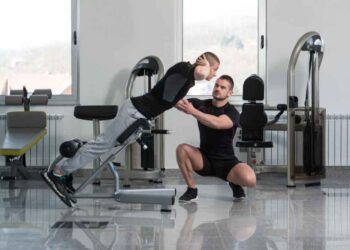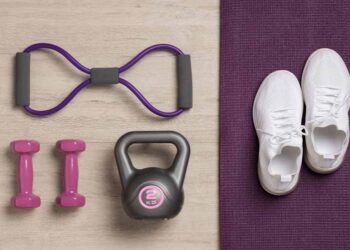When it comes to leg workouts, most people focus on the thighs and glutes, but what about the calves? Have you ever wondered why some people have beautifully sculpted lower legs while others struggle to build muscle in that area? Is it simply a matter of genetics, or is there something more you can do to bulk up your calves?
In this article, we’ll explore the often-overlooked world of calf exercises and how they can help you build stronger and more defined calf muscles. From understanding the anatomy of the calf muscles to discovering the best exercises to engage and strengthen them, we’ll give you all the information you need to take your calf training to new heights.
Key Takeaways:
- Don’t neglect your calf muscles in your workout routine.
- Understanding the anatomy of the calf muscles is crucial for effective training.
- Incorporate specific calf exercises into your routine for optimal results.
- Calf exercises can be done at home or in the gym.
- Strong calf muscles offer benefits beyond aesthetics.
Understanding Calf Muscle Anatomy
The calf region is comprised of two important muscles: the gastrocnemius and the soleus. These muscles play a crucial role in the overall strength and function of the calves.
Gastrocnemius Muscle
The gastrocnemius is the largest and most visible calf muscle. It consists of two heads – the medial head and the lateral head. The gastrocnemius muscle is responsible for giving the calf its muscular appearance. It primarily functions in bending the knee and pushing off the ground during activities like running and jumping. When well-developed, the gastrocnemius adds shape and definition to the calf region.
Soleus Muscle
The soleus muscle is a flatter and longer muscle located beneath the gastrocnemius. It plays a crucial role in various activities such as standing, walking, and running. The soleus muscle assists in flexing the foot downward, allowing for proper ankle movement and stability. Although not as visible as the gastrocnemius, the soleus is essential for balance and lower body strength.
Understanding the anatomy of these calf muscles is key to effectively targeting and engaging them during calf exercises. By focusing on both the gastrocnemius and the soleus, you can achieve balanced and well-developed calf muscles.
Best Calf Exercises to Build Muscle
Building strong and defined calf muscles requires targeted exercises that specifically engage the gastrocnemius and soleus muscles. Incorporating the following calf exercises into your training routine will help you achieve optimal results:
Donkey Calf Raises: This exercise involves using a weight plate positioned on a weight belt to increase intensity and deepen the stretch in the calves. Begin by standing on the edge of a stair or elevated platform with your toes on the edge and your heels hanging off. Place the weight plate on the weight belt and position it on your lower back. Lower your heels as far down as you can and then rise up onto your tiptoes, squeezing your calves at the top. Repeat for the recommended number of repetitions.
- Sit-to-Stand Calf Raises: This exercise focuses on the soleus muscle by bending the knees and moving the heels up. Begin by sitting on a bench or chair with your feet flat on the floor and a dumbbell in each hand. Bend your knees and push through your heels to raise your body up, lifting your heels off the floor. Hold the top position for a moment, then lower your heels back down to the starting position. Repeat for the recommended number of repetitions.
- Toe Touch Farmer’s Walks: This exercise is performed by walking on tiptoes while holding dumbbells. It provides a great way to fatigue the calf muscles. Start by holding a dumbbell in each hand and stand tall with your chest up and shoulders back. Lift your heels off the ground and balance on the balls of your feet, then walk forward, maintaining the tiptoe position. Take small steps and focus on engaging your calves throughout the exercise. Continue for the recommended distance or duration.
- Dumbbell Calf Hops: This exercise mimics the motion of a jump rope and effectively strengthens and tones the calves. Begin by holding a dumbbell in each hand and standing with your feet shoulder-width apart. Lift your heels off the ground and balance on the balls of your feet, then rapidly hop up and down while rotating your wrists as if skipping rope. Continue hopping for the recommended number of repetitions or time.
- 1-½ Calf Raises: This exercise involves performing a standing calf raise with an added partial repetition, increasing time under tension. Start by standing with your feet shoulder-width apart and your heels hanging off the edge of a step or raised platform. Rise up onto your tiptoes, then lower halfway down before rising up again to the top position. This counts as one repetition. Repeat for the recommended number of repetitions.
- Single-Leg Calf Raises: This exercise is effective for isolating and targeting each calf muscle individually. Stand on one foot near a wall or support for balance. Lift the opposite foot off the ground and rise up onto the ball of your standing foot, lifting your heel as high as possible. Hold the top position briefly, then lower your heel back down. Repeat for the recommended number of repetitions, then switch sides.
Incorporating these best calf exercises into your training routine will help you build stronger, more defined calf muscles. Remember to focus on proper form, intensity, and a full range of motion to maximize the benefits of each exercise.
| Exercise | Description |
|---|---|
| Donkey Calf Raises | Use a weight plate positioned on a weight belt to increase intensity and deepen the stretch in the calves. Lower your heels as far down as you can and then rise up onto your tiptoes, squeezing your calves at the top. Repeat for the recommended number of repetitions. |
| Sit-to-Stand Calf Raises | Sit on a bench or chair with feet flat on the floor and dumbbells in hand. Bend your knees and push through your heels to lift your body up, lifting your heels off the floor. Hold the top position for a moment, then lower your heels back down. Repeat for the recommended number of repetitions. |
| Toe Touch Farmer’s Walks | Walk on tiptoes while holding dumbbells. Start with standing tall, lift your heels off the ground, and balance on the balls of your feet. Walk forward maintaining the tiptoe position. Continue for the recommended distance or duration. |
| Dumbbell Calf Hops | Mimic the motion of a jump rope while holding dumbbells. Start with feet shoulder-width apart, lift your heels off the ground, and rapidly hop up and down while rotating your wrists as if skipping a rope. Continue for the recommended number of repetitions or time. |
| 1-½ Calf Raises | Perform a standing calf raise with an added partial repetition. Start with standing feet shoulder-width apart and heels hanging off a step or raised platform. Rise up onto your tiptoes, lower halfway down, then rise up again to the top position. Repeat for the recommended number of repetitions. |
| Single-Leg Calf Raises | Target each calf muscle individually. Stand on one foot near a wall or support for balance. Lift the opposite foot off the ground, rise up onto the ball of your standing foot, and lift your heel as high as possible. Hold the top position briefly, then lower your heel back down. Repeat for the recommended number of repetitions, then switch sides. |
Calf Exercises at Home
If you prefer working out at home or have limited access to a gym, there are still plenty of effective calf exercises you can do. Bodyweight calf exercises are adaptable to all fitness levels and can easily be integrated into your daily routine.
Some of the best calf exercises at home include:
- Calf Launchers
- Calf Raises
- Single-Leg Calf Raises
- Downward Dog
- Jumping Jacks
- Butt Kickers
- Jump Squats
- Raised Heel Squats
- Mountain Climbers
- Outward Calf Raises
- Inward Calf Raises
- Isometric Calf Raise Holds
These exercises target the calf muscles and can be modified to increase or decrease intensity based on your fitness level. By incorporating these exercises into your home workouts, you can effectively strengthen and sculpt your calves.
Whether you have a home gym or prefer to exercise without equipment, these calf exercises will help you achieve your fitness goals. Incorporate them into your calves workout plan and watch your calf muscles grow!
Benefits of Strong Calves and Common Calf Injuries
Strong calves are more than just a cosmetic feature; they offer a range of benefits that can improve your overall fitness and well-being. By incorporating exercises to strengthen your calves into your training routine, you can enhance your balance, stability, and athletic performance.
Developing well-defined calf muscles can significantly improve your ability to perform everyday movements with ease. Whether you’re walking, running, or jumping, strong calves provide the power and stability necessary for optimal performance. When your calves are properly conditioned, you’ll notice improved agility and endurance, allowing you to push yourself further and achieve your fitness goals.
However, neglecting calf strength can lead to various calf injuries that can hinder your progress and mobility. Muscle strains, cramps, and tendonitis are common injuries that can occur when calf muscles are weak and not properly conditioned. It’s essential to listen to your body and avoid pushing through pain during calf exercises to prevent exacerbating any existing injuries.
By incorporating targeted exercises to strengthen and condition your calves into your training routine, you can effectively reduce the risk of calf injuries. These exercises can help strengthen the muscles, improve flexibility, and enhance overall lower body strength and function.
Remember, a well-rounded calves training routine should include exercises that specifically target the calf muscles, such as calf raises, heel drops, and calf stretches. A gradual increase in intensity and incorporating variations in your routine can help maximize your calf muscle development.
Don’t let weak calf muscles hold you back from reaching your fitness goals. Strengthen your calves, reduce your risk of injury, and enhance your overall athletic performance with a well-designed calf training routine.
| Benefits of Strong Calves | Common Calf Injuries |
|---|---|
| Improved balance | Muscle strains |
| Enhanced stability | Cramps |
| Optimized athletic performance | Tendonitis |
| Greater power and endurance | |
| Improved mobility and agility |
Conclusion
Developing stronger and more defined calves requires targeted exercises that engage the gastrocnemius and soleus muscles. Incorporating calves exercises such as Donkey Calf Raises, Sit-to-Stand Calf Raises, Toe Touch Farmer’s Walks, Dumbbell Calf Hops, 1-½ Calf Raises, and Single-Leg Calf Raises into your calves training routine can help you achieve optimal results. Whether you prefer working out at a gym or at home, there are plenty of effective calf exercises to choose from. Remember to focus on proper form, intensity, and a full range of motion to maximize the benefits of each exercise. Building stronger calves not only enhances your physical appearance but also improves your overall lower body strength and athletic performance.














